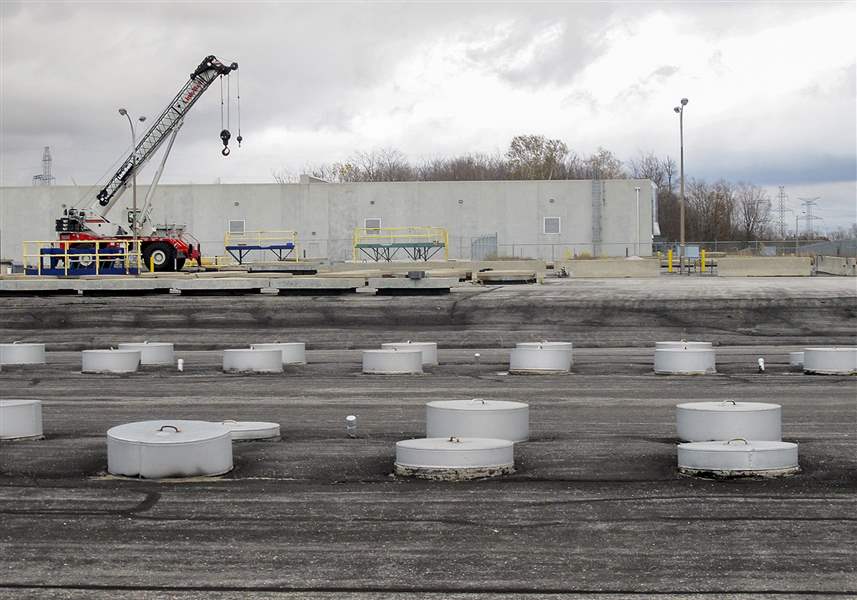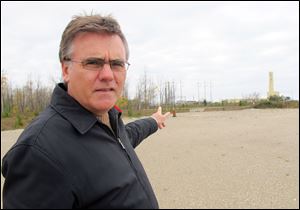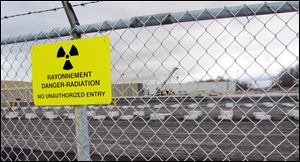
World awaiting Canada decision on nuclear waste
Burial plan near Lake Huron has implications for industry
2/22/2016
Ontario Power Generation has been using holding chambers for intermediate-level radioactive waste for years at the Bruce nuclear complex near Kincardine, Ont.
ASSOCIATED PRESS
Though delayed for at least another two months, Canada’s eventual decision over the fate of a 15-year-old proposal to build a deep underground repository for low and intermediate-level nuclear waste a mile from Lake Huron is being watched on both sides of the border.
Many people believe the decision has broader implications for the U.S. and the global nuclear industry at large, as well as future management of the Great Lakes, which hold a fifth of the world’s fresh surface water.

Ontario Power Generation has been using holding chambers for intermediate-level radioactive waste for years at the Bruce nuclear complex near Kincardine, Ont.
Canadian Minister of Environment and Climate Change Catherine McKenna said days after taking office in November that she planned to issue a decision March 1.
She announced Thursday that a decision is being put off indefinitely.
The announcement stated she is giving Ontario Power Generation, the utility behind the project, until April 18 to submit more information. OPG said it has already produced 12,500 pages.
Even if it’s a few months from now, the decision will likely come during heightened sensitivity over the Great Lakes because of the Flint water crisis.
Flint someday hopes to draw its own water from Lake Huron. Detroit draws raw water from that lake to supply tap water to itself, Flint, and other communities.
Groups representing more than 22 million people in the United States and Canada are imploring Ms. McKenna to stop the underground nuclear-waste repository in its tracks.
Ms. McKenna has been in her position since Nov. 4, the same day Prime Minister Justin Trudeau and his other cabinet members were sworn into office.
OPG maintains the project can be done safely, with waste sent down a shaft that will be nearly a half-mile deep into hard rock that geologists believe hasn’t shifted for 450 million years.
The Great Lakes region has 40 million residents, 30 million in the United States and 10 million in Canada.
Of 184 resolutions against it, many have come from municipalities and governmental organizations in the United States, including Ohio but especially the closest state to the site, Michigan.

Toledo, Oregon, and Port Clinton are opposed, joining a block of opposition throughout southwest Ontario and the eastern half of Michigan’s Lower Peninsula.
That opposition includes heavy-hitters such as Chicago, Detroit, Milwaukee, Rochester, N.Y., as well as the Washington-based National Association of Counties and the Great Lakes Legislative Caucus.
A Nov. 5 letter of opposition was signed by 32 members of Congress and sent to Mr. Trudeau.
“Given the critical importance of these shared waters to our countries, and the potentially catastrophic damages to the lakes from a nuclear accident, we urge your administration not to approve this repository and consider alternative locations outside the Great Lakes Basin,” according to the letter, which included signatures from U.S. Sens. Debbie Stabenow (D., Mich.), Gary Peters (D., Mich.), and Sherrod Brown (D., Ohio), as well as U.S. Reps. Marcy Kaptur (D., Toledo) and Debbie Dingell (D., Dearborn).
Risk cited
Mr. Brown told The Blade he’s opposed because storing radioactive waste “so close to drinking water creates an unnecessary risk.”
Likewise, Mr. Peters said the project “puts this treasured resource in jeopardy.”
“This is an issue of binational concern,” Miss Kaptur said.
Longtime anti-nuclear activist Kevin Kamps, of Maryland-based Beyond Nuclear, said he’s been fighting the project since its inception 15 years ago.
In a recent essay he got published on counterpunch.org, Mr. Kamps drew parallels between the Flint water crisis and the Ontario nuclear project in terms of government accountability and oversight.
“What it boils down to is maximum convenience for Ontario Power Generation,” Mr. Kamps said.

In this Nov. 1, 2013 photo, Neal Kelly, spokesman for Ontario Power Generation, stands in the area of the Bruce Power nuclear power complex in Kincardine, Ontario, where OPG proposes to drill a chamber to permanently store low- and intermediate-level radioactive waste more than 2,000 feet below the earths surface near Lake Huron.
On Bruce site
The project is planned on the massive eight-reactor Bruce nuclear complex in tiny Kincardine, Ont., about a four-hour drive north of Toledo.
OPG spokesman Neal Kelly said the cost estimate for construction remains $1 billion. He said he was not aware of a $2.65 billion figure the project’s opponents came up with by adding in other costs the utility submitted for an environmental impact statement.
Project engineering is half completed, Mr. Kelly said.
Twenty of Canada’s 22 nuclear reactors are in Ontario. New Brunswick and Quebec also have one apiece.
OPG manages the 20 Ontario-based reactors.
Its proposal is to put all radioactive waste other than spent fuel down the mine shaft.
Low and intermediate-level waste is typically protective clothing, gloves, and miscellaneous plant parts.
Spent fuel, the most radioactive form of waste in civilian hands, would be sent elsewhere for disposal.
OPG said it has been storing the low-level and intermediate-level radioactive waste above ground on its Bruce complex near Lake Huron now for more than 40 years.
OPG has long had Kincardine’s support. But it has said it will not proceed without also getting support from the local Saugeen Ojibway Nations, known as SON.
“As of today, we don’t have that support,” Mr. Kelly said. “We continue to stand by that commitment.”

This 2013 photo shows rows of chambers holding intermediate-level radioactive waste in shallow pits at the Bruce Power nuclear complex near Kincardine, Ontario.
Civilian project
The project would be North America’s first known as a Deep Geologic Repository in civilian hands.
The only other one is a U.S. military repository in New Mexico for military waste. Two others are in civilian hands in Europe.
Rod McCullum, senior director of used fuel and decommissioning at the Washington-based Nuclear Energy Institute, said the project could be a turning point for deep repositories, which the nuclear industry hopes is the future for managing radioactive waste.
“What it means is Canada would have a solution,” Mr. McCullum said. “The more common this becomes, the more people become comfortable with it.”
Adding another dimension to the controversy is the uncertainty over what to do with the high-level waste.
In 2010, Canada began doing what the United States did in the 1980s: Start looking for a permanent site to entomb its growing piles of spent reactor fuel.
While Nevada’s Yucca Mountain remains on hold in the United States, Canada has nine sites under consideration by its Nuclear Waste Management Organization.
Three are near the Bruce nuclear complex and also short distances from Lake Huron.
Opponents fear if the deep repository plan is approved in Kincardine, it will become more politically expedient to put high-level waste nearby.
Michael Krizanc, communications director for the Nuclear Waste Management Organization, said the two are “very separate projects and very separate processes.”
But he said communities are enticed by the prospect of $20 billion of investments if they host the high-level site, a financial “game-changer” for them.
Communities under consideration have come forward voluntarily and can duck out anytime, Mr. Krizanc said.
“It has the ability to affect many people,” Mr. Krizanc said.
His agency is on pace to select a high-level site about 2023. Another 10 years would be required for construction, meaning the fastest-case scenario for that type of repository is the mid 2030s, he said.
The deep repository, by contrast, would take about seven years to build.
The Bruce nuclear complex is one of the world’s largest. The site generates 25 percent of Ontario’s electricity.
It sits along the Lake Huron shoreline across from the upper tip of Michigan’s thumb region and employs about 4,000 people. Their wages and other revenue from the nuclear industry support half of Kincardine’s 12,000 jobs.
The utility wants to bury waste there to save on transportation costs, as well as the difficulties in getting another site approved.
Michigan had once proposed a multistate, low-level radioactive waste dump in Lenawee County’s Riga Township, across the Ohio state line from Sylvania and West Toledo. That plan was scrapped in the early 1990s because of protests.
Ohio was required to build a dump after Michigan withdrew from the regional compact, but never did.
Contact Tom Henry at: thenry@theblade.com, 419-724-6079, or via Twitter @ecowriterohio.